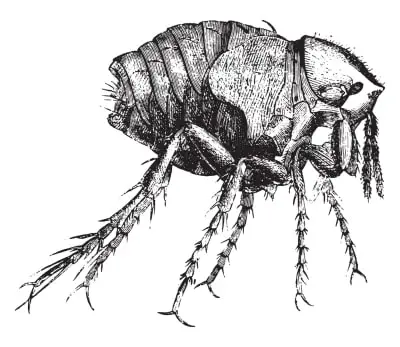We’ve all experienced it before. You go on a week-long camping trip or even just a day hike and then experience the dreadful itching of chigger bites. From that point on, you’re extremely cautious – trying to avoid chiggers at all costs by avoiding places that you think they may dwell.
A common question concerning chiggers is can chiggers stay in your clothes?
Chiggers can stay in your clothes but it is uncommon for them to remain there very long. Chigger larvae need to feed on a warm-blooded host in order to advance to the next stage of their life cycle and prefer to reside in low-level vegetation.
Chiggers can, however, attach to an item of clothing and remain long enough for you to bring them into your home so you probably want to take steps to minimize this.
Table of Contents
What Are Chiggers?

Chiggers are microscopic mites of the family Trombiculidae. Not actually an insect, chiggers are arachnids. Chiggers are also called “red bugs”. These tiny mites are red in color and very hard to see with the naked eye. Chigger bites usually result in intense itching which can last for several days.
Contrary to popular belief, a chigger does not actually embed the skin. Instead, it finds a soft area of skin, usually an area where clothing is tight, where it can attach. It then injects an enzyme that dissolves the skin. The skin responds by forming a funnel-like structure called a stylostome through which the chigger can drink the dissolved skin cells. The result is irritation and a red bump.
Pretty gross huh?
Since chiggers do not embed the skin, using nail polish to “kill” them is not an effective treatment for bites. Calamine lotion or hydrocortisone cream to relieve itchy skin is your best course of action for treating chigger bites.
The Life Cycle Of A Chigger
Chiggers can live anywhere from 50-70 days. The life cycle of Trombiculids consists of four stages: egg, larva, nymph, and adult. It is the larvae that feed on skin cells and cause intense itching.
Female adult chiggers lay anywhere from 3 to 8 eggs in vegetation. In 5 to 7 days these eggs hatch larvae which have only 6 legs. After attaching to a host and feeding, the chigger larvae drop off. Over the next one or two weeks, the larvae will molt into an eight-legged nymph. Finally, over the next 2 to 4 weeks, the nymph becomes an adult.
Where Chiggers Live
At least one species of Trombiculidae can be found in every country in the world.
It is often believed, especially in the southeastern US, that chiggers reside in Spanish moss hanging from trees. This, however, is a myth as chiggers prefer low-level, moist, vegetative areas where it can more easily attach itself to a host. They are most prevalent in the early summer as plant growth is thicker, providing a more suitable habitat such as tall grass.
Living in the southeast, I myself used to believe that chiggers lived in moss and would avoid it like the plague. If some were to accidentally brush over the top of my head while walking under a tree, I would freak out! But, entomologists have repeatedly tried to find Trombiculidae in Spanish moss and have yet to be successful. They simply don’t live there.
Chiggers In Your Clothing

While camping or hiking, you may venture into a tall grassy area infested by chiggers. Actually, it’s not very easy for them to attach to your skin. In fact, in cases where you only received several bites, you may have actually had hundreds or thousands of mites on you. It stands to reason that a few chiggers may be hanging out in your clothes – at least for a little while anyway. This is especially true with clothing made from a material that is not tightly woven.
How long do chiggers live on clothes?
Although not impossible, it is unlikely the pest will hang around in your clothes for more than a few hours. The larvae have a mission to feed on a host in order to proceed to the nymph stage of their cycle. Hanging around in your flannel shirt or underwear is probably not an ideal location for the chigger, especially if your clothes are dry.
With that being said, there are still many people who report unexplained occurrences where they have received bites inside there home several days after being in the woods. Could these bites have occurred as a result of bringing them in the home by way of clothing and infesting the home leading to future bites? Possibly.
Get Rid Of Chiggers
If you’re like me, I don’t like to take chances with things like infestations. Taking precautions to ensure there are no critters lurking in your clothing is not a bad idea. It stands to reason that you can bring chiggers in your home within a few hours of exposing yourself outside. Therefore, taking steps to remove any chiggers from your clothes is a high priority.
Can you wash your clothes to kill chiggers?

You want to put your clothes in the washer as soon as you enter your home. Strip off all your clothing at the washing machine and put all your clothes in. Wash your clothing in hot water only, using detergent of course. This alone should kill any mites left lingering in your laundry.
While doing your laundry, it’s a great time to take a shower. Use warm water, soap, and a washcloth.
As an added measure of safety, be sure to dry your clothes in the dryer on the hottest setting possible for your particular clothing to kill any remaining chiggers.
Heat kills chiggers so this is a double whammy against them to ensure your clothing and home remain chigger-free. Also, chiggers can’t live in temperatures below 42° F but you probably don’t have a dedicated freezer lying around for your clothes.
Can You Get Chiggers In Your Hair?
Just as chiggers can get into your clothing, they can get into your hair. Vigorous washing with shampoo while you take a hot shower or bath should eliminate any stray chiggers before they latch onto to your skin.
Prevent Chigger Bites On Dogs

Dogs are even more likely than humans to go into areas where chiggers live. Luckily, their bodies are protected by their thick coat. They can, however, get chigger bites in their head area – particularly their ears. If the dog is on a flea and tick medication, this should repel chiggers as well. If not and they become exposed, it may be a good idea to give them a bath.
Dogs can suffer from chigger bites just as humans do with itching so prevention is the easiest option. If your dog is often in the wooded outdoors it’s a good idea to let your veterinarian put them on a flea and tick preventative to help prevent chigger bites on your pet.
Prevent Chiggers
As far as getting chiggers on yourself or in your clothes, prevention here is also the best option. Wearing protective clothing made of tightly-woven fabric will help reduce the possibility of chiggers attaching themselves to your skin. Long pants and long-sleeve shirts are a must. Be sure to tuck in your shirt. If wearing boots, tuck your pants legs into them as well.
There are several products you can use to help prevent chiggers from attaching to your skin and clothing. Products containing DEET are very effective in repelling chiggers as well as other biting critters in the woods. These products can be used on clothes as well as your skin.
Products containing permethrin like Sawyer Products Insect Repellent are also highly effective at treating both your clothes and your gear from infestation. It’s odorless when dry and is as effective as 100% DEET to control chiggers and help prevent bites.







